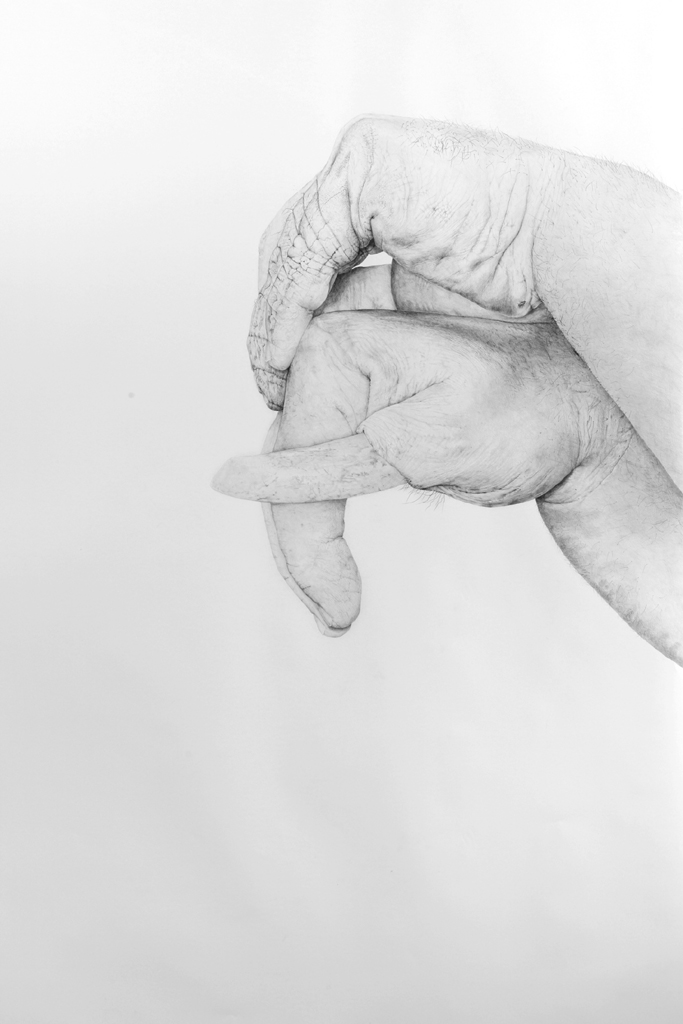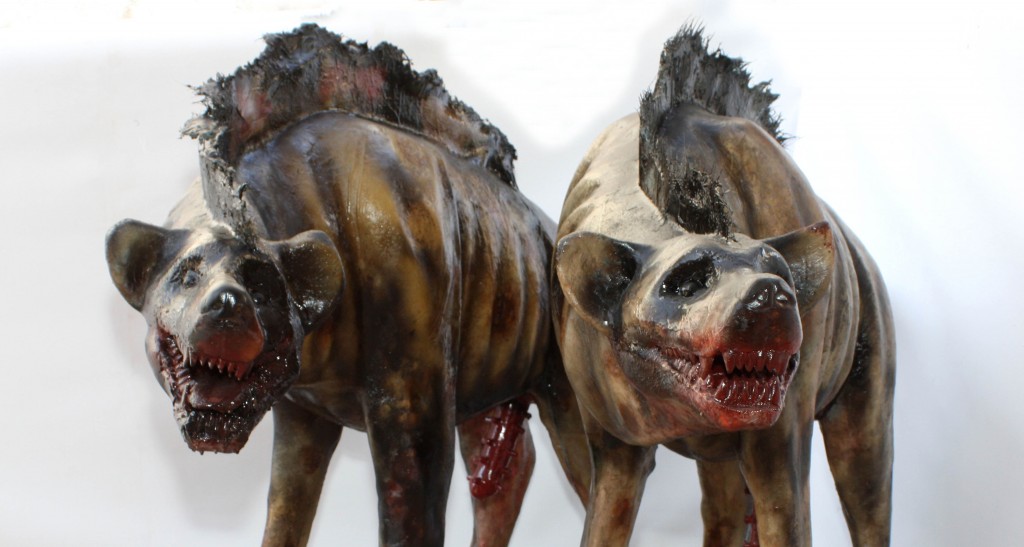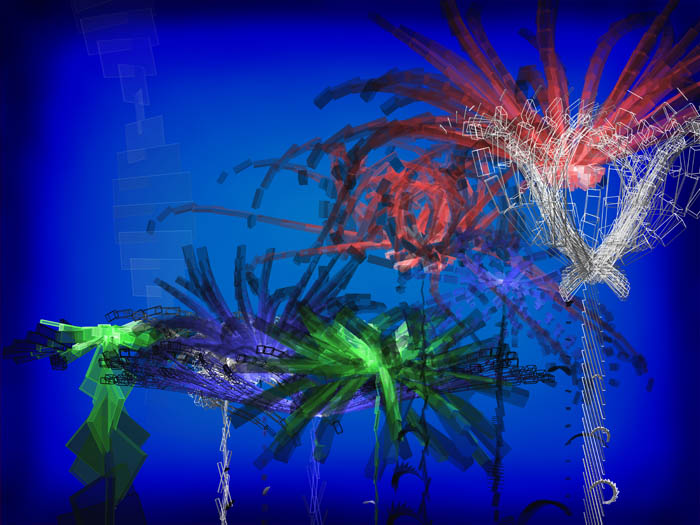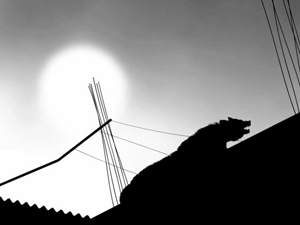Swinging between images of violence and compassion, strangeness and beauty, Manimal, the new exhibition at the Herzliya Museum of Art is as disturbing as it is awesome. Its title alludes to its theme: man’s relationship to animals, or animals’ relationship to man, a topic taken in various directions by 11 artists from Israel and abroad selected by curators Dalia Levin and Ghila Limon. A variety of media is represented: drawings, paintings, photographs, video, sculpture and mixed-media installations.
Anthropomorphism – the attribution of human characteristics to non-human creatures- is expressed in artwork dating from prehistoric times, its presence suggesting mystic-religious cults. Assa Meshullam’s exhibit The Scroll of Ro’aHem, albeit a product of his imagination, falls within this category. Open for perusal in the gallery is a book that he has written describing an imaginary world where its ruler is a hybrid of a man and bitch; a figure with a human physique but having animal qualities. Sited on the wall above, is the insignia of this imaginary cult: a silver wand flanked by the black wings of a bird.

Hybrids created by the fusion of human hands and the body parts of animals and birds are the subject of some large, meticulously rendered drawings by Dana Harel whose source of inspiration appears to be shadow puppetry. To give one example: she draws a pair of hands bent into the shape of an elephant’s head, one thumb forming its tusk. To complete the illusion, whiskers of hair sprout from wrinkled ‘elephant’ skin.
Creatures held in captivity are the subject of two works. One of these is a lightweight offering by Dina Shenhav consisting of brightly colored, naïve paintings of fish in an underwater setting. The sting in the fin here is that tears drip from their eyes causing the spectator to wonder if, unbeknown to us, fish possess feelings, and are capable of mourning their loss of freedom.

And then one turns to Hyenas and Other Men – a memorable photo series by South African photographer Pieter Hugo. Travelling through Nigeria in 2005, he attached himself to a troupe of itinerant performers who parade hyenas and snakes through the streets in order to draw crowds, who then buy their potions and charms. Among the remarkable portraits he took of these ‘hyena men,” singly or in a group, proudly showing off the animals they control, is one of a man named Mallam Mantari Lamal. He is shown with his ‘personal’ hyena Mainasara, one hand holding a stick, the other a chain attached to the neck of his charge.
In a description of his experiences, entitled The Dog’s Master, Hugo writes about the paradoxical relationship existing between these handlers and their animals – something that cannot be gauged from these photographs: He describes it as “sometimes doting and affectionate, sometimes brutal and cruel.”

Adi Nachshon’s striking installation Gang-Bang Society also features hyenas. But here, their ferocious nature and propensity to attack and kill in packs is used as a metaphor for the vicious behavior of human beings acting as a group. Sited in a gallery space rigged up to evoke an army training camp, Nachshon has placed five life-like hyenas constructed from painted fiberglass and other materials. Jaws open, fangs exposed, one is caged, the others are ready to pounce and kill.
Compassion for creatures, in this instance dead animals, is the feature of Apologies, an emotive video by Shaun Gladwell, one of several he showed in the Australian pavilion last summer at the Art Biennale in Venice. The touching story-line refers to the fact that kangaroos in the Australian outback are habitually run over by speeding cars and left on the road to die. In Gladwell’s staged sequences, a black-helmeted motorcycle rider stops at the roadside to pick up the carcasses, gently cradling them in his arm before giving them a decent burial.

Fractal Flowers 2010 is an amazing interactive installation by Miguel Chevalier (b. Mexico City; based in Paris), a pioneer in digital art. Taking up two huge walls of a gallery, it features an enchanting flower garden set against a brilliant blue background. But these are not ordinary flowers, with soft petals and leaves, but objects existing in an artificial wonderland populated by web-like shapes, crystalline forms, fronds and fountains of color. By means of sensors, the activity of these plants is coordinated with the movement of people in the gallery. When all is still the flowers are dormant. Move about, and these huge blooms start to grow, bow and wave before vanishing like a puff of smoke and being replaced by new images.
While this artificial paradise does not connect directly to the animal theme of this show, it has relevance regarding the animal world; if only to remind one of the power that science and technology has today to create or mutate living things, whether a plant or a living creature.

Presented simultaneously but separate to this exhibition are two works – a video piece and a site-specific installation by Carlos Amorales, an artist who lives and works in Amsterdam and Mexico City. His video piece, accompanied by a pulsating sound track suitable for a horror film, is titled Manimal (this is the source of the title of the group exhibition, used with Amorales’ permission) Paralleling our own fears about future apocalyptic events, this scary, nocturnal piece is made up of silhouetted forms. It starts with the camera panning deep into a forest of dead trees. Gradually a lone wolf appears, then another. A pack is formed and it races across the countryside to reach and overrun a city, represented by airport buildings where all is still and dark. That is, except for planes with illuminated interiors flying overhead, a sight which increases one’s sense of alarm and unease when viewing this final scene.
The installation that Amorales has prepared for one of the largest galleries in the Museum comprises hundreds of tiny hard-edged shapes cut from sheets of black acrylic. Suspended at different levels from the ceiling, the overall effect is of a huge but delicate, kinetic sculpture with light bouncing off it at many angles. Despite its title Explosion , this writer cannot agree with the opinion of curator Hadas Maor, (given in an online text,) that this piece is a metaphor for “rift, dissolution and estrangement” and conceals “a good deal of violence.”
Herzliya Museum for Contemporary Art – 4 Ha’banim St., Herzliya
Till July 31th, 2010.
Open times: Tuesday, Thursday 16:00-20:00
Monday, Wednesday, Friday, Saturday 10:00-14:00
Sunday – closed
ANGELA LEVINE





